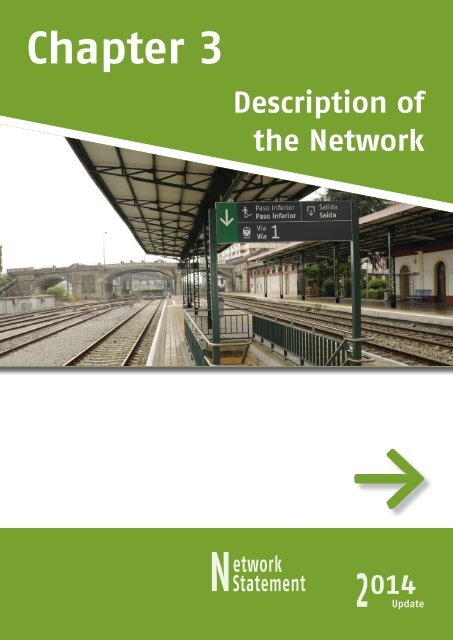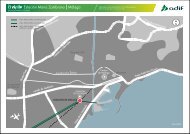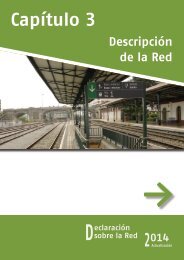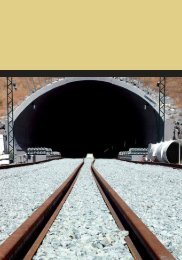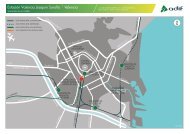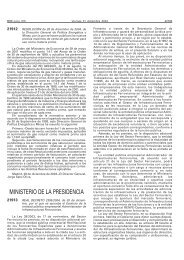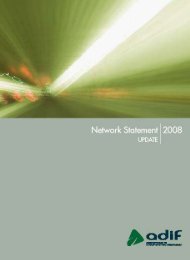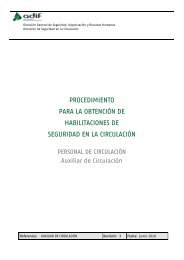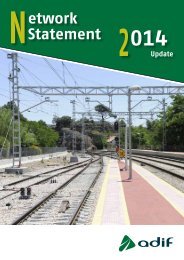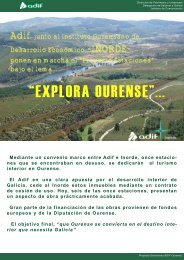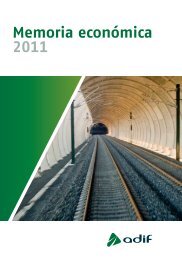Chapter 3 - Adif
Chapter 3 - Adif
Chapter 3 - Adif
You also want an ePaper? Increase the reach of your titles
YUMPU automatically turns print PDFs into web optimized ePapers that Google loves.
<strong>Chapter</strong> 3<br />
Description of<br />
the Network<br />
Network<br />
Statement<br />
2 014<br />
Update
<strong>Chapter</strong> 3<br />
Description of<br />
the Network<br />
Network<br />
Statement<br />
2 014<br />
Update
3<br />
3.1<br />
INTRODUCtion<br />
This chapter describes the main characteristics of <strong>Adif</strong> managed network, available to request for Capacity Allocation.<br />
3.2<br />
Scope of <strong>Adif</strong><br />
managed network<br />
The management of rail infrastructure and, where<br />
appropriate, its construction shall correspond - within the<br />
scope of state competence - to one or several state-owned<br />
companies attached to the Ministry of Public Works with<br />
their own legal personality, full capacity to operate and own<br />
patrimony, in accordance with Final Provision two of Royal<br />
Decree-Law 15/2013 of 13 December on restructuring of the<br />
state-owned company “Administrador de Infraestructuras<br />
Ferroviarias “<strong>Adif</strong> other urgent measures in the economic<br />
sphere.<br />
Article 1.2 of Royal Decree Law 15/2013 states that <strong>Adif</strong>-Alta<br />
Velocidad shall assume the duties assigned to the rail<br />
infrastructure manager by Law 39/2003, of 17 November<br />
of the Rail Sector, with respect to rail infrastructures that<br />
it owns and others attributable in the future. To all matters<br />
not covered by this provision, and regarding powers granted<br />
to it, shall apply <strong>Chapter</strong> V of section II in Law 39/2003 of<br />
17 November, of the Rail Sector, and other provisions of said<br />
rule applicable to the rail infrastructure manager.<br />
In accordance with article 1.7 of Royal Decree Law 15/2013,<br />
of 13 December, <strong>Adif</strong>-Alta Velocidad has entrusted to <strong>Adif</strong><br />
the infrastructure capacity management, control, traffic<br />
and safety systems, among others.<br />
Annex I to this NS - sections a) and c) - includes the<br />
Catalogue of Lines and Sections in the General Interest<br />
Railway Network managed by <strong>Adif</strong> pursuant to Article 38<br />
of Royal Decree-Law 4/2013, of 22 February parliamentary<br />
proceeded and approved as Law 11/2013 of 26 July.<br />
<strong>Adif</strong> Managed Network primarily has combined traffic lines<br />
(Freight and Passengers). It has three lines with different<br />
gauges:<br />
♦ ♦ Iberian gauge (1,668 mm).<br />
♦♦<br />
♦♦<br />
UIC gauge (1,435 mm).<br />
Metric gauge (1,000 mm).<br />
Some line sections have a third rail, so that these sections<br />
have a double gauge (Iberian and UIC).<br />
Main lines of <strong>Adif</strong> Managed Network have double tracks.<br />
There is an information system called CIRTRA (Traffic by<br />
Sections), systematically registering the characteristics of<br />
<strong>Adif</strong> managed network.<br />
Maps included in Annex H have information on identification<br />
and location of the main stations and railway junctions of<br />
<strong>Adif</strong> Managed Network as well as on distances in kilometers<br />
between these, with details of different types of track (single<br />
track and double track, and electrified or non-electrified).<br />
The contents of Annexes are for information purposes<br />
only. In case of discrepancy between the contents of these<br />
annexes and regulatory documentation, the latter shall<br />
prevail over Annexes.<br />
There is a supplementary document to the NS called<br />
Capacity Manual which is available for RUs and Applicants<br />
for consultation purposes, which is sent by the Department<br />
of Planning and Capacity Management reporting to the<br />
Department Office of Planning and Network Management,<br />
to all those who perform traffic. This document details<br />
specific rules for capacity allocation applicable to every<br />
Network line.<br />
3.2.1. Geographic Limits<br />
See Maps, Annex H.<br />
3.2.2. Connections to other Networks<br />
<strong>Adif</strong> Managed Network is connected to Portuguese network<br />
(REFER) generally with Iberian gauge through border points<br />
of Tuy, Fuentes de Oñoro and Badajoz, and to network of<br />
France (RFF) with Iberian gauge through Irún, Portbou and<br />
La Tour de Carol (although transit to France network through<br />
these accesses requires trains to change to UIC gauge) and<br />
with UIC gauge through Figueres-Vilafant performed by TP<br />
Ferro Infrastructure Manager.<br />
Description of the Network<br />
41
3.2.3. Additional Information on the Network<br />
Integration of rail transport in Europe requires a technical<br />
compatibility of infrastructure, rolling stock and signaling,<br />
as well as a compatibility of legal and operational procedures<br />
across European rail network in order to achieve the goal of<br />
Rail System Interoperability. In Spain there are currently<br />
1,974 km of lines operating with ERTMS.<br />
3.3<br />
3.3.1. Geographic Identification<br />
Description of the<br />
Network Managed by AdiF<br />
3.3.1.1. Track Typologies<br />
<strong>Adif</strong> Managed Network is essentially made up of:<br />
♦♦<br />
♦♦<br />
♦♦<br />
♦♦<br />
Non-electrified single track.<br />
Electrified single track.<br />
Non-electrified double track.<br />
Electrified double track.<br />
See Map 9, Annex H.<br />
3.3.1.2. Track Gauges<br />
Map 14 in Annex H, shows track types on <strong>Adif</strong> Managed<br />
Network, as described in section 3.2.<br />
3.3.1.3. Passenger Stations and<br />
Logistics and Technical Freight<br />
Facilities<br />
See sections 3.6 and 3.7 and see Maps 2 and 3, Annex H.<br />
3.3.2. Network Features<br />
3.3.2.1. Loading Gauge<br />
Technical Instruction applicable to Network Gauge (1985<br />
Edition) includes gauge characteristics applicable to <strong>Adif</strong><br />
Managed Network with Iberian gauge.<br />
General Instruction, IG 66, Loading Rules sets the standards<br />
that RUs have to fulfill in order to condition the load within<br />
gauge limits.<br />
Figure “Gauge Table” includes a graphical scheme applicable<br />
to load carriages running on Iberian gauge along <strong>Adif</strong><br />
managed network - by virtue of General Instruction IG 66 -<br />
and the remaining main gauges applicable to <strong>Adif</strong> managed<br />
network.<br />
//<br />
Combined Transport Profile<br />
Traffic of trains used to transport Swap Bodies, Removable<br />
bodies, Semitrailers and Containers, depending on size and<br />
type of wagons used is governed by Set point Series C no. 47,<br />
of 5 May 2006, along with Annexes 1, 2 and 3 thereto.<br />
42<br />
Network Statement Update 2014 V.0
3<br />
//<br />
Loading Gauge scheme<br />
IBERIAN LOADING GAUGE (1,668 mm)<br />
1430<br />
2340<br />
380<br />
50<br />
1928<br />
1568<br />
145<br />
430<br />
130<br />
3290<br />
3670<br />
4070<br />
4300<br />
400 230<br />
3010<br />
3300<br />
2734<br />
3274<br />
2584<br />
50<br />
1668<br />
140<br />
Description of the Network<br />
43
UIC GAUGE (1,435 mm)<br />
Pending Publication in Official State Gazette is the new updated Technical Instruction on national and international transit of<br />
carriages on UIC gauge.<br />
44<br />
Network Statement Update 2014 V.0
3<br />
METRIC GAUGE (1,000 mm)<br />
For electrified lines<br />
450<br />
1075<br />
1507<br />
1440<br />
3200<br />
870<br />
630<br />
500<br />
450<br />
150<br />
100<br />
80<br />
100<br />
150<br />
400<br />
3800<br />
4100<br />
For electrified lines<br />
950<br />
1240<br />
1507<br />
1440<br />
3200<br />
870<br />
630<br />
500<br />
450<br />
150<br />
100<br />
80<br />
100<br />
150<br />
400<br />
3600<br />
3900<br />
(Dimensiones en mm)<br />
Pending Publication in Official State Gazette is the new updated Technical Instruction.<br />
Description of the Network<br />
45
3.3.2.2. Load Limits<br />
//<br />
Load per Axle and Linear Load<br />
Railway Network of General Interest lines and sections with Iberian gauge managed by <strong>Adif</strong> are classified, for this purpose,<br />
into nine categories, with defining characteristics as shown in the following table, based on the maximum load per axle or per<br />
linear meter.<br />
Type of line<br />
Per Axle<br />
Maximum load<br />
Per Meter<br />
A 16, 0 t 5, 0 t<br />
B1 18, 0 t 5, 0 t<br />
B2 18, 0 t 6, 4 t<br />
C2 20, 0 t 6, 4 t<br />
C3 20, 0 t 7, 2 t<br />
C4 20, 0 t 8, 0 t<br />
D2 22, 5 t 6, 4 t<br />
D3 22, 5 t 7, 2 t<br />
D4 22, 5 t 8, 0 t<br />
At present most of the lines of the Network Managed by <strong>Adif</strong> are Category D4. There are, however, some specific restrictions<br />
affecting certain points and lines, which can be consulted on the Operating Manual.<br />
On meter-gauge lines, maximum axle load is 15.0 t and per linear meter is 8.0 t.<br />
//<br />
Towable Load Limit<br />
The “Table of Maximum Loads” is the official document<br />
that lays down towable loads, for each locomotive and for<br />
different lines on the Network. It is available to RUs and other<br />
Applicants in the Department for Capacity Management<br />
and Planning reporting to the Department of Planning and<br />
Network Management.<br />
In general, the maximum load is determined on the basis of<br />
considering two parameters:<br />
♦♦<br />
♦♦<br />
The characteristic worst gradient on the train route.<br />
The maximum load of the locomotives, depending on<br />
the characteristics of afore gradient.<br />
Maximum load represents the load that a locomotive can<br />
technically carry if operating in extreme conditions.<br />
The application of the maximum load to trains can result,<br />
especially in case of diesel locomotives, in low traffic speeds<br />
which may prove to be incompatible with exploitation<br />
or with a reasonable use of track capacity. Therefore,<br />
regardless of the maximum load established, <strong>Adif</strong> may set<br />
conditions or reject applications that result in unsuitable<br />
speeds due to the load given by Applicants for a particular<br />
request for Capacity.<br />
3.3.2.3. Characteristic Line Gradients<br />
Maps 7 and 7.1 of Annex H show characteristic line gradients<br />
on the rail network most important sections, for both<br />
running directions.<br />
3.3.2.4. Maximum Speeds<br />
//<br />
Types of Rolling Stock<br />
For speed limits purposes, the rolling stock is classified by<br />
types, in relation to the following determinants:<br />
♦♦<br />
♦♦<br />
The maximum authorized speed for each vehicle.<br />
Acceleration without compensation admitted by<br />
vehicles, according to the following five classes<br />
considered:<br />
TYPES N A B C D<br />
Acceleration (m / s 2 ) 0, 65 1 1, 2 1, 5 1, 8<br />
The resulting train type shall correspond to the worst “Type” for any vehicle in the train set.<br />
46<br />
Network Statement Update 2014 V.0
3<br />
//<br />
Table of Maximum Speed<br />
The “Table of Maximum Speeds and Permanent Information”<br />
is the official document outlining the maximum speeds<br />
authorized on each line. High Speed Network lines allow<br />
speeds of 300 km/h and above. The main lines of the<br />
conventional network with Iberian gauge generally take<br />
speeds between 160 and 220 km/h.<br />
Metric gauge lines take speeds between 50 and 100 km / h.<br />
Included in Annex H, Maps 8 and 8.1 is an overview of the<br />
maximum speeds on each route.<br />
3.3.2.5. Maximum Train Lengths<br />
The length of the rails at stations as well as other operating<br />
conditioning factors, are basic to determine the maximum<br />
length of trains on different lines. Annex H shows Maps 10,<br />
10.1, and Maps 11 and 11.1 of maximum train lengths allowed<br />
on each line, differentiating freight and passenger traffic.<br />
Within the framework of the Plan to Promote and Stimulate<br />
Freight Transport by Rail, <strong>Adif</strong> promotes management<br />
actions to enable and meet the demand for increased lengths<br />
of trains by RUs (Maps 11 and 11.1 in Annex H).<br />
Currently trains with a special length up to 750 m are<br />
authorized to run on Barcelona - French Border and Madrid<br />
- Valencia routes.<br />
In order to run with a particular length, it is necessary to<br />
request specific authorization to the Department of Planning<br />
and Capacity Management reporting to the Department<br />
Office of Planning and Network Management for regular or<br />
occasional trains and H24 Network Management Centre for<br />
immediate trains.<br />
3.3.2.6. Electric Power Supply<br />
<strong>Adif</strong> Managed Network has more than 9,000 km electrified<br />
lines, with different gauges, using two different types of<br />
voltage:<br />
Direct Current<br />
In general, a nominal voltage of 3,000 V is used for<br />
Conventional Network and 1,500 V for Metric Gauge<br />
Network.<br />
Alternate Current<br />
Catenary supplies 25,000 V power at 50 Hz, normally<br />
confined its use to High Speed Network lines.<br />
Electric power available is limited depending on the power<br />
supplied by network substations. Maps 9 and 9.1 in Annex<br />
H include electrified sections of <strong>Adif</strong> Managed Network, as<br />
well as electrification type available therein.<br />
3.3.3. Safety Systems, Communications<br />
and Traffic Control<br />
3.3.3.1. Safety Systems<br />
<strong>Adif</strong> Managed Network has signaling and blocking systems<br />
of various technologies, and there is a tendency to use<br />
electronic interlocking with centralized remote control (CTC)<br />
at Control Stations and Regulation and Control Centers.<br />
♦♦<br />
Mechanical interlocking, which authorizations<br />
are based on the ratio of keys and levers, and the<br />
transmission of the signals and switch position is<br />
generally mechanical.<br />
Interlocking<br />
Interlocking is a set of physical and logical elements, that<br />
within the geographical area of a station or traffic unit, it<br />
automatically performs orders, monitoring and verification<br />
of shunting, detentions, releases and other actions necessary<br />
for the proper functioning of all railway signaling elements<br />
under their control, as well as ancillary systems which are to<br />
be considered case by case, pursuant to the functionality set<br />
out in the corresponding Operating Program.<br />
Operations on interlocking can be done locally, from an<br />
operator station at an Office of Traffic and remotely from<br />
Centralized Traffic Control (CTC) systems.<br />
Depending on the technology used, interlocking systems are<br />
classified into:<br />
♦♦<br />
Electronic interlocking (ENCE), based on<br />
microprocessors.<br />
♦♦<br />
Electric interlocking, using relay logics, and depending<br />
on the used architecture receive different names:<br />
geographic modules, free wiring, etc.<br />
Train Detection<br />
Track circuits (CDV)<br />
Track circuit detects the occupation by a railway vehicle,<br />
of a certain track section. Every rolling stock entering the<br />
area protected by track circuit, it reports occupancy to the<br />
interlocking.<br />
When the rail vehicle leaves the area protected by the track<br />
circuit, it safely reports to the interlocking that the area is<br />
vacant.<br />
The physical configuration of track circuits is defined in the<br />
Operating Program of each interlocking.<br />
Axle counters (CE)<br />
Axle counter locates the train on a particular track section<br />
by counting axles that pass through the ends of the section.<br />
Interlocking safely receives information of occupancy /<br />
vacancy of the track section controlled by the counter.<br />
The definition of the physical configuration of axle counters,<br />
as well as for track circuits, is made in the interlocking<br />
Exploitation Program.<br />
Description of the Network<br />
47
Blocking<br />
Automatic Control Block System (BCA)<br />
Safety distance is kept regulating the train speed, never<br />
exceeding the speed limit that the driver continuously<br />
receives via cab signaling. There are various systems of BCA<br />
in <strong>Adif</strong> Managed Network. The section corresponding to<br />
safety systems shows the various systems available.<br />
Side Signal Block System (BSL)<br />
A safe distance between trains is ensured by signal<br />
indications. It is similar to the BA listed below, though<br />
specific of high-speed lines.<br />
Automatic Release Block System (BLA)<br />
This blocking system generally has one-block section<br />
between stations, which is protected automatically by<br />
signals and axle counter devices.<br />
Depending on the track and signaling conditions, there are<br />
several types of Automatic Release Block System, similar to<br />
the Automatic Block System, described as follows.<br />
Automatic Block System (BA)<br />
It generally has intermediate block sections between<br />
stations, which are automatically protected by signals.<br />
Depending on the signaling and track conditions, there is a<br />
Single-Track Automatic Block System (BAU), a double track<br />
Automatic Block System (BAD), and an Automatic Pooled<br />
Block System (BAB).<br />
Radio Traffic Control (CCR)<br />
This block system is used on lines with little traffic, and train<br />
traffic is ensured by a permanently reporting to the Head of<br />
CCR of the status of the trains on sections, of authorizations<br />
given to drivers and notice of train arrivals. Closed radio<br />
communications are used.<br />
Manual Electric Block (BEM)<br />
Track blocking is made by Traffic Managers through an<br />
electrical device.<br />
Telephone Block (BT)<br />
Blocking the section between two open stations is ensured<br />
by telephone messages sent between Operating Managers.<br />
The existing blocks on every line are included in Map 12,<br />
Annex H.<br />
3.3.3.2. Automatic Train Protection<br />
Systems<br />
Train traffic on certain lines may require motor vehicles to<br />
be equipped with any of these ATP systems, as indicated<br />
in the Capacity Manual. ASFA is installed on all main lines<br />
of General Interest Rail Network, RFIG, managed by <strong>Adif</strong>,<br />
and it might be mandatory that rolling stock running on the<br />
network is equipped with it and operates it during service. It<br />
is also mandatory for trains to run on a single-agent regime.<br />
Detailed in Annex H Map 13 are the lines that are equipped<br />
with these systems.<br />
ERTMS<br />
Traffic control, signaling and assisted operation system that<br />
meets European standards of interoperability. It currently<br />
combines two subsystems: ETCS (European Traffic Control<br />
System focused on signaling and train protection), and<br />
GSM-R (Global System for Mobile Communications in<br />
Railways performing communications).<br />
LZB<br />
Control, signaling and driving assistance system that<br />
continuously monitors train speed and controls its running<br />
service via cab signaling.<br />
ATP-EBICAB<br />
This family of protection systems is based on providing<br />
timely information about balises installed on track for<br />
continuous speed supervision.<br />
ASFA, Announcement of Signals and Automatic<br />
Braking<br />
The system announces in cab signal indications through<br />
balises, setting speed controls based on these indications.<br />
This system in its most modern development is called ASFA<br />
Digital.<br />
3.3.3.3. Traffic Control and<br />
Management Systems<br />
Da Vinci<br />
Control and Management Platform that integrates and<br />
centralizes subsystems of signaling, electrification,<br />
communications, etc. enabling their remote monitoring and<br />
communication.<br />
CTC, Centralized Traffic Control<br />
A platform in a central control station centralizes interlocking<br />
and blocking of a line or area.<br />
CRC, Control and Regulation Centre<br />
Centre that manages, organizes and coordinates rail traffic<br />
and safety systems.<br />
PRO, Regional Operations Office<br />
Centre where it is possible to manage exclusively an<br />
interlocking of a line facility, by CRC transfer. It is considered<br />
a second level of traffic control.<br />
PLO, Operations Local Office<br />
Centre where it is possible to manage traffic of a line section,<br />
by CRC transfer. It is considered a third level of traffic control.<br />
48<br />
Network Statement Update 2014 V.0
3<br />
3.3.3.4. Communication Systems<br />
Train traffic on certain lines may require motor vehicles to<br />
be equipped with one of these systems, as indicated in the<br />
Capacity Manual.<br />
//<br />
Mobile Communications<br />
GSM-R (Voice and Data)<br />
It’s a development of GSM technology, specific for<br />
communication and rail applications, with exclusive<br />
frequency bands to avoid any type of interference. As ERTMS<br />
subsystem it shall enable European rail interoperability.<br />
High speed lines already have GSM-R.<br />
Train-Ground<br />
Analogue radiotelephone system called Train-Ground that<br />
enables individual communications between trains and the<br />
Control Centre or Regulation and Control Centre, which is<br />
installed on most Network main lines, in view of a gradual<br />
migration towards GSM-R system planned for the entire<br />
network. Radiotelephone system is mandatory for train<br />
traffic running on a single-agent regime.<br />
3.3.3.5. Protection and Safety<br />
The mission of <strong>Adif</strong> Safety and Security a Department is<br />
to lead, coordinate and organize the actions of human and<br />
technical resources in order to safeguard resources of the<br />
company, security of persons and goods, as well as to direct<br />
civil protection policy and monitor compliance therewith.<br />
Management of safety and security develops from Safety<br />
and Security Centers (CPS), which are geographically<br />
distributed and respond and manage immediately, alerts and<br />
alarms within their scope, activates necessary resources for<br />
processing and collects and transmits necessary information<br />
for a comprehensive management. Territorial CPS are<br />
coordinated by the Center for Self-Defense and Security<br />
(CASH24) integrated into the H24 Network Management<br />
Centre.<br />
RFIG managed by <strong>Adif</strong> offers Self-protection Plans for<br />
infrastructures identified in the catalog I of the Basic Self-<br />
Protection Standard, where periodically maintenance of<br />
efficacy is performed through inspections of facilities,<br />
simulations, documentation reviews and audits of the<br />
entire system of self-protection. These Protection Plans are<br />
registered in the Autonomous Communities where powers<br />
are transferred in the field of civil protection.<br />
<strong>Adif</strong> has a Master Emergency Actions Plan (PDAE) that<br />
provides an overall performance criteria in case of<br />
emergency.<br />
Description of the Network<br />
49
3.4.1. Specialized Lines<br />
There are certain specialized lines for passenger traffic<br />
where operations are restricted to certain types of traffic,<br />
or such a restriction will only have effect on a preferential<br />
allocation of capacity for this particular traffic or on the<br />
regulation of train traffic. The complete list of specialized<br />
3.4<br />
Traffic<br />
Restrictions<br />
lines may be consulted in the Capacity Manual, which is<br />
available for RUs and Applicants for consultation, and shall<br />
be sent to whomever performs traffic by the Department<br />
for Planning and Capacity Management reporting to the<br />
Department for Planning and Network Management.<br />
3.4.2. Environmental Standards<br />
RUs shall comply with environmental regulation valid in<br />
Spain, as applicable, especially in terms of control of fire,<br />
noise, smoke emissions, etc. In case of noncompliance, <strong>Adif</strong><br />
may adopt environmental measures for train traffic and<br />
stabling.<br />
3.4.3. Transport of Dangerous Goods<br />
Transport of dangerous goods on <strong>Adif</strong> Managed Network is<br />
governed by Regulation concerning International Transport<br />
of Dangerous Goods by Rail, RID, RD 412/2001, of 20 April,<br />
and by valid General Instruction, IG 43.<br />
Major traffic restrictions covered are as follows:<br />
♦♦<br />
Prohibition to run on lines that pass through towns<br />
when there are alternatives to bypass these.<br />
♦♦<br />
♦♦<br />
In general stabling at inhabited stations shall not be<br />
planned.<br />
In general, detentions in tunnels over 100 meters<br />
long shall not be planned.<br />
In case of failure, <strong>Adif</strong> may adopt appropriate measures for<br />
traffic or stabling of trains.<br />
3.4.4. Restrictions in Tunnels<br />
There is a complementary document to the NS called<br />
Traffic Manual that is available for RUs and Applicants for<br />
consultation, which shall be sent by the Department of<br />
Traffic Safety , to whomever performs traffic.<br />
3.4.5. Restrictions in Bridges / Viaducts<br />
There is a complementary document to the NS called<br />
Traffic Manual that is available for RUs and Applicants for<br />
consultation, which shall be sent by the Department of<br />
Traffic Safety , to whomever performs traffic.<br />
The effective period of opening and closing stations may be<br />
consulted in Instructions B published monthly by each of<br />
the Department of Operations reporting to the Department<br />
Office of Maintenance and Operation of Conventional<br />
Network of <strong>Adif</strong>, or in the so-called Train Document if<br />
applicable.<br />
Infrastructure<br />
availability<br />
3.5<br />
Despite the general tendency to remotely control <strong>Adif</strong><br />
Managed Network main lines through CTC, there are still<br />
some parts that are open to traffic all day long.<br />
50<br />
Network Statement Update 2014 V.0
3<br />
Passenger<br />
3.6 Stations<br />
The management of the 1,948 existing stations in the RFIG corresponds to <strong>Adif</strong>. <strong>Adif</strong>-Alta Velocidad has entrusted to <strong>Adif</strong> the<br />
management of stations it owns (Map 17 in Annex H).<br />
3.6.1. Main Stations<br />
Main stations managed by <strong>Adif</strong> are seen as landmarks of<br />
the city, equipped with accessible spaces, functional, and<br />
environmentally friendly where customers can enjoy a<br />
variety of services related to railways and modal exchange,<br />
commercial offer and social and cultural activities.<br />
<strong>Adif</strong> priority is to design and construct rail stations with<br />
comprehensive sustainability criteria, considering the whole<br />
life cycle of the station and quality service provision based<br />
on the characteristics of each station, taking into account:<br />
♦♦<br />
Suitable dimensioning of spaces and equipment.<br />
♦♦<br />
A proper operation of facilities (cleaning,<br />
maintenance, conservation, conditioning, etc.).<br />
♦♦<br />
♦♦<br />
♦♦<br />
Creation of safe environments.<br />
A commercial offer geared to the needs of customers<br />
and the city.<br />
Information related to the station and services in it,<br />
in Spanish and, if necessary, in the official languages<br />
of the respective Autonomous Communities.<br />
A model of stations marketing is offered to customers and<br />
cities by a diverse and attractive commercial offer, under<br />
the following brands:<br />
and<br />
A list of stations is classified by categories in TABLE 4<br />
“Station Classification” by virtue of Order FOM/2336/2012<br />
of 31 October, amending Order FOM/898/2005 of 8 April,<br />
which fixes the level of railway charges set out in Articles<br />
74 and 75 of Law 39/2003, of 17 November, of Rail Sector.<br />
It also includes major passenger stations on <strong>Adif</strong> managed<br />
RFIG, in Map 2, Annex H. For more information, please see<br />
www.adif.es<br />
3.6.2. Commuter Stations<br />
Commuter stations provide public service in large urban<br />
and areas of influence, representing a sustainable public<br />
transport, efficient and with an attractive offer to mobility<br />
demands in this area. They aim to offer public service<br />
with criteria of quality, efficiency, innovation, and focus<br />
on clients, safety and sustainability, combining business<br />
criteria with those of state and territorial public interest.<br />
Commuter hub providing services are: Asturias, Barcelona,<br />
Bilbao, Cadiz, Madrid, Malaga, Murcia/Alicante, San Sebastian,<br />
Santander, Sevilla, Valencia and Zaragoza.<br />
<strong>Adif</strong> and RENFE-Operadora have signed an agreement<br />
entrusting RENFE-Operadora with the integrated<br />
management and administration of these stations.<br />
3.6.3. Stations on Metric Gauge Lines<br />
These are stations with commuter and regional services that structure rail in Spanish territory.<br />
Description of the Network<br />
51
3.6.4. Other Stations with Passenger Service<br />
Stations which are medium-sized or small, located in towns that are not province capitals and which have commercial stops<br />
for passenger trains.<br />
3.6.5. Accessibility Plan of <strong>Adif</strong> Stations<br />
In line with <strong>Adif</strong> commitment on accessibility of stations and<br />
services provided therein, the Accessibility Plan of Stations<br />
contemplates their adaptation, so as to allow accessibility<br />
for disabled people to rail services. At main stations, work<br />
is being done to allow access to services for people hearing,<br />
speech and visually impaired.<br />
In general, the height of the platforms in Spain conforms<br />
to the provisions in the Commission Decision 2008/164/CE<br />
of 21 December 2007, published in DOUE of 07/03/2008,<br />
concerning the technical specification of interoperability<br />
relating to persons with reduced mobility in high speed and<br />
conventional Transeuropean rail systems.<br />
On platforms of conventional rail network, two nominal<br />
values of platform height are permitted, namely, 550 mm<br />
above the running surface for conventional traffic and 760<br />
mm above the running surface for high-speed traffic.<br />
Furthermore as stated in section 7.4. Specific cases,<br />
subsection 7.4.1.1. Platform height, under Technical<br />
Specification for Interoperability TSI on a permanent basis,<br />
a platform height of 680 mm above the running surface is<br />
authorized for platforms specifically designed for commuter<br />
or regional traffic.<br />
In metric gauge stations, platforms are located at a nominal<br />
height of 1.05 m. (Royal Decree 1544/2007, of 23 November).<br />
3.6.6. <strong>Adif</strong> Dialoga Service<br />
It’s a service designed by ADIF -in the Plan of Accessible<br />
Services- to facilitate access to information and<br />
communication in railway environments to persons with<br />
deafness or hearing impaired, using the latest technologies<br />
in the market and meeting the commitments arising from<br />
the implementation of the Spanish Sign Language.<br />
The service consists in the following action lines:<br />
♦♦<br />
♦♦<br />
Information via mobile and communication via<br />
texting.<br />
Insertion of pre-recorded Spanish sign language and<br />
text messages on information monitors at stations.<br />
♦♦<br />
♦♦<br />
Video-interpreting Service.<br />
Imparting courses of Spanish sign language to staff<br />
at Stations.<br />
Stations where this service has been implemented are: A<br />
Coruña, Albacete Los Llanos, Alacant-Terminal, Barcelona<br />
Sants, Ciudad Real, Cordoba, Cuenca Fernando Zóbel, Gijón,<br />
Girona, León, Madrid Chamartín, Madrid Puerta de Atocha,<br />
Ourense, Oviedo, Requena-Utiel, Santiago de Compostela,<br />
Sevilla Santa Justa, Valencia Joaquín Sorolla, Valladolid<br />
Campo Grande, VIialia Málaga María Zambrano and Vigo<br />
Guixar.<br />
3.6.7. Interactive Information Points and Desks<br />
<strong>Adif</strong> has 30 information points to facilitate customers and<br />
passengers at the station - in an interactive and accessible<br />
way- the most relevant information of the station (train<br />
services, commercial, intermodal ...) and the rail traffic<br />
situation.<br />
Aforementioned information points are located at the<br />
following 17 stations: Albacete Los Llanos, Barcelona<br />
Sants, Ciudad Real, Córdoba, Intermodal Abando Indalecio<br />
Prieto, Lleida Pirineus, Madrid Chamartín, Madrid Puerta de<br />
Atocha, Málaga María Zambrano, Pontevedra, Puertollano,<br />
Salamanca, Sevilla Santa Justa, Valencia Joaquín Sorolla,<br />
Valencia Estaciò del Nord, Valladolid Campo Grande and<br />
Zaragoza Delicias.<br />
Furthermore, we have also installed 10 reception desks,<br />
conceived as the first point of guidance and information<br />
to customers and travelers at the station, at 7 stations:<br />
Barcelona Sants, Madrid Chamartín, Madrid Puerta de<br />
Atocha, Málaga María Zambrano, Sevilla Santa Justa,<br />
Valencia Joaquín Sorolla and Zaragoza Delicias.<br />
52<br />
Network Statement Update 2014 V.0
3<br />
3.7<br />
Technical Installations and<br />
Freight Logistics Facilities<br />
http://www.adif.es/<strong>Adif</strong>Web/instalacionesMapa.jsp<br />
<strong>Adif</strong>, through their network of facilities, facilitates a modal<br />
exchange of freight and provides Railway Undertakings and<br />
Applicants with logistics services necessary to add value to<br />
the transport chain.<br />
If <strong>Adif</strong> does not directly or indirectly perform such services,<br />
they shall establish the corresponding contract of space<br />
availability to use their logistics facilities.<br />
Types of Logistic Facilities<br />
Based on the type of facilities, their size and location,<br />
resources of <strong>Adif</strong> and type of operation performed therein,<br />
these are classified into:<br />
♦♦<br />
♦♦<br />
Technical Facilities.<br />
These are rail facilities to perform operations on<br />
railway stock relating to their stabling and formation<br />
for service.<br />
These are made up of tracks and facilities of signaling,<br />
safety and electrification, which are managed by the<br />
Rail Infrastructure Administrator, and help to ensure<br />
an overall efficiency of the rail system.<br />
Logistic Facilities.<br />
These are cargo terminals exclusively dedicated to<br />
providing logistics services related to handling and<br />
storage of freight, adding value to the transport<br />
chain.<br />
These facilities are at least the rail infrastructure<br />
required for transport modal exchange and available<br />
spaces for loading / unloading of freight. They may<br />
also include other facilities such as warehouses,<br />
roads, office buildings, etc.<br />
established various management models for their logistic<br />
facilities, looking for a more efficient system and ensuring<br />
in its implementation a criteria of transparency, objectivity<br />
and non-discrimination. These management models are:<br />
a) Direct Management, that is the provision of<br />
Supplementary and Ancillary Services by <strong>Adif</strong>, either<br />
with their own resources or through the establishment<br />
of ad hoc service contracts. Information of managed<br />
services under this model are published on the Web of<br />
<strong>Adif</strong> and the list of Top Logistics Facilities specified in<br />
section 3.7.1.<br />
b) Management at their own risk, that is the provision<br />
of Supplementary and Ancillary Services by third parties<br />
that have the corresponding contract on availability of<br />
space and resources. The list of managed services under<br />
this model is in section 3.7.2.<br />
c) Self-provision Management, that is the provision<br />
of Supplementary and Ancillary Services by Railway<br />
Undertakings, for themselves and their own traffic. The<br />
list of facilities that can be operated under this model is<br />
in section 3.7.3.<br />
<strong>Adif</strong> website likewise includes Additional and Supplementary<br />
Services provided at each facility, as well as the<br />
provision regime and schedule which at certain facilities is<br />
24 hours daily, 365 days a year for acceptance and consignment<br />
of trains on <strong>Adif</strong> web is posted the list of facilities open<br />
24 hours daily.<br />
Likewise, <strong>Adif</strong> may provide services at times other than<br />
those listed in www.adif.es. In this case, the provision<br />
of such services shall be pursuant to prior agreement<br />
between the parties, based on service specific conditions,<br />
associated operations, duration, frequency, price or any<br />
other circumstance which may be expressed in a concrete<br />
and definite agreement.<br />
♦♦<br />
Logistic Centers<br />
Logistics centers shall be facilities depending on their<br />
strategic location on major rail corridors, size and<br />
resources devoted to these.<br />
Management Models, Characteristics and<br />
Services<br />
<strong>Adif</strong> currently manages and owns 53 Top Logistics Facilities<br />
- which are facilities and logistics centers with capacity<br />
and resources to provide Supplementary Services and- if<br />
appropriate- Auxiliary. Location of Top Logistics Facilities is<br />
shown in Map 3- Annex H.<br />
In order to promote freight transport rail, <strong>Adif</strong> has<br />
Concerted Quality Agreements<br />
<strong>Adif</strong> promotes Concerted Quality Agreements with actors<br />
participating in rail freight transport. These Agreements<br />
establish, by mutual agreement, the commitments of every<br />
participating member to achieve the quality levels expected<br />
rail logistics services provided at their facilities.<br />
Concerted Quality Agreements are a tool of <strong>Adif</strong> Logistics<br />
Services model, designed to ease the operation at their<br />
facilities, enhancing competitive conditions for railway<br />
undertakings and logistics operators using them, in line with<br />
the strategic plan designed by the Ministry of Public Works.<br />
Description of the Network<br />
53
3.7.1. Freight Main Logistics Facilities<br />
A Coruña San Diego Granollers Mercancías Pontevedra<br />
Alcázar de San Juan Mercancías Grisén Portbou Mercancías<br />
Algeciras Mercancías Hueva Mercancías Sagunto Mercancías<br />
As Gándaras Irún Mercancías Salamanca<br />
Barcelona Can Tunís Júndiz Samper<br />
Barcelona Morrot León Mercancías San Roque - La Línea Mercancías<br />
Bilbao Mercancías Lugo de Llanera Sevilla La Negrilla<br />
Busdongo Lugo Mercancías Silla Mercancías<br />
Castellbisbal Madrid Abroñigal Tarragona Mercancías<br />
Complejo Pasaia - Lezo Martorell Seat Torrelavega Mercancías<br />
Complejo Taboadela - Ourense Mataporquera Valencia Fuente San Luís<br />
Complejo Valladolid Mérida Mercancías Venta de Baños Mercancías<br />
Complejo Villaverde Miranda de Ebro Mercancías Vicálvaro Mercancías<br />
Constantí Monforte de Lemos Mercancías Vigo Guixar<br />
Córdoba El Higuerón Murcia Mercancías Villafría<br />
Cosmos Muriedas Zaragoza Arrabal<br />
Escombreras Noáin Zaragoza Plaza<br />
Fuentes de Oñoro<br />
Pamplona<br />
54<br />
Network Statement Update 2014 V.0
3<br />
3.7.2. Services at their own risk at Main Freight Logistic<br />
Facilities<br />
FACILITY MANAGED SERVICES UNDERTAKING<br />
Complejo Valladolid ITUs Handling TCB RAILWAY TRANSPORT S.L.<br />
Constantí<br />
Granollers Mercancías<br />
Global management of services at<br />
facilities<br />
Global management of services at<br />
facilities<br />
TRANSLISA<br />
UTE Terminal Granollers<br />
Murcia Mercancías ITUs Handling REFEER TERMINAL A.I.E.<br />
Noáin ITUs Handling TERMINAL CATALUNYA S.A.<br />
Portbou Mercancías<br />
Global management of services at<br />
facilities<br />
FERROSER Servicios Auxiliares S.A.<br />
Tarragona Mercancías ITUs Handling Transportes Portuarios S.A.<br />
Villafría<br />
ITUs Handling<br />
Logística Multimodal Castilla y<br />
León S.A.<br />
Zaragoza Plaza ITUs Handling Noatum Rail Terminal Zaragoza<br />
Description of the Network<br />
55
3.7.3. Freight Logistics Facilities that can be managed<br />
under self-provision<br />
A Susana * Els Monjos * L’Arboc * Santa Eulalia del Campo<br />
Albacete Mercancías * Féculas de Navarra Magaz Santiago de Compostela *<br />
Albolote * Ferrol * Manresa * Sarria *<br />
Alconera * Flix * Manzanares * Selgua *<br />
Algodor * Fuencarral *<br />
Manzanares - Soto<br />
El Real *<br />
Sestao - Urbinaga *<br />
Alhondiguilla -<br />
Villaviciosa *<br />
Gandía Mercancías<br />
María de Huerva<br />
Sevilla Majarabique<br />
Mercancías *<br />
Almería Getafe Centro * Medina del Campo * Tamarite Altorricón *<br />
Altsasu Getafe Industrial * Mengibar Artichuela * Tardienta<br />
Alzira Girona Mercaderies * Moncofa Tembleque<br />
Aranda de Duero Granada * Montcada - Bifurcaciò * Teruel *<br />
Araia Granollers Canovelles * Montornés - Butano * Texeiro *<br />
Aranjuez * Guillarey Monzón - Río Cinca * Toral de los Vados<br />
Arévalo * Hernani * Mora de Rubielos Toro *<br />
Ávila * Herradón - La Cañada * Morata de Jalón Torrejón Mercancías *<br />
Azuqueca de Henares * Jadraque * Nava del Rey * Tres Camins *<br />
Badajoz Jerez de los Caballeros * Navalperal Valencia de Alcántara<br />
Bobadilla Jerez Mercancías * Novelda - Aspe * Vallecas *<br />
Briviesca La Encina O Barco de Valdeorras Vedra - Rivadulla *<br />
Burriana - Alquerías La Felguera * Osorno Vic Mercaderies *<br />
Cabezón de Pisuerga La Llagosta * Oural * Viana<br />
Cáceres La Robla * Peñarroya Pueblo Nuevo * Vila - Real<br />
Canfranc * La Roda de Albacete Picón de los Serranos Villacañas<br />
Casetas La Roda de Andalucía * Pinto * Villarrobledo<br />
Castillejo- Añover * La Salud * Plá de Vilanoveta * Villaverde -Alto *<br />
Cella Lalín * Ponferrada Mercancías * Villaverde Orcasitas *<br />
Chapela (Redondela de<br />
Galicia *<br />
Les Borges del Camp * Puerto Escandón Zafra *<br />
Cuarte de Huerva *<br />
Linares Baeza<br />
Mercancías *<br />
Redondela *<br />
Zarzalejo<br />
Curtis * Llanos de Granja * Robledo de Chavela Zuera<br />
Dos Hermanas * Los Prados Mercancías * San Felices Zumarraga<br />
El Carpio de Córdoba Los Rosales * San Vicente de Castellet<br />
El Sequero - Arrubal Luceni Sanchidrián<br />
*Logistics facility for which a railway undertaking requested its management under self-provision.<br />
56<br />
Network Statement Update 2014 V.0
3<br />
3.8.1. Tracks to set trains<br />
3.8 Other Facilities<br />
For additional information please address:<br />
Department of Logistics Services<br />
Estación de Chamartín, Andén 1. Agustín de Foxá s/n. 28036 Madrid<br />
3.8.2. Storage Sidings<br />
For additional information please address:<br />
Department of Logistics Services<br />
Estación de Chamartín, Andén 1. Agustín de Foxá s/n. 28036 Madrid<br />
3.8.3. Facilities for Rolling Stock Maintenance<br />
<strong>Adif</strong> does not currently offer rolling stock maintenance services.<br />
3.8.4. Refueling Facilities<br />
These are facilities with appropriate technical means for<br />
dispensing diesel for traction. These facilities enable having<br />
fuel used for traction and dispensing it to rail vehicles with<br />
appropriate safety measures.<br />
There is a network of fuel supply locations, directly run<br />
by <strong>Adif</strong>. Map 4 of Annex H shows a list of diesel supply<br />
points available for <strong>Adif</strong> Managed Network. For additional<br />
information see www.adif.es or check with:<br />
Department of Fuel Management<br />
Avenida Pío XII, 97 1ª planta. 28036 Madrid<br />
3.8.5. Ancillary Facilities<br />
These are facilities where operations on rolling stock can<br />
be performed, regarding damage to wheels, hot boxes,<br />
overloads, loading gauge control, cargo stowed etc. They are<br />
designed for traffic safety and have appropriate technologies<br />
to fulfill their mission.<br />
There is a set of weighbridges distributed along the Rail<br />
Network of General Interest managed by <strong>Adif</strong>, in order to<br />
identify overweights in wagons, avoiding derailments and<br />
over-efforts on the infrastructure. Specifically, there are 27<br />
dynamic weighbridges of automatic operation, all equipped<br />
with remote control, and their location is shown on map 16<br />
of Annex H. <strong>Adif</strong> through the Department of Operational<br />
Systems and TIC reporting to the Department Office for<br />
Network Planning and Management keeps the weighbridge<br />
stock and contrast wagons in accordance with valid<br />
regulations.<br />
Description of the Network<br />
57
3.8.6. Facilities for Track Gauge Changes<br />
On <strong>Adif</strong> Managed Network there are currently two track<br />
gauges interoperable with each other: UIC Gauge (1,435<br />
mm) and Iberian gauge (1,668 mm). In order to facilitate<br />
internal connections between both gauges, as well as to<br />
other European networks, automatic systems have been<br />
developed called Track Gauge Changers. In other traditional<br />
facilities, a physical change of gauge is possible by changing<br />
axles or bogies, or by physical transhipment of the freight.<br />
There are also facilities for transhipment of containers and<br />
freight at border points of Irun and Portbou. Their location is<br />
listed in Map 14, Annex H.<br />
3.8.6.1. Track Gauge Changers<br />
These are facilities where track gauge automatically changes<br />
upon passenger trains passing with reduced speeds. There<br />
are two systems:<br />
♦♦<br />
♦♦<br />
With TALGO technology<br />
With CAF technology<br />
Furthermore, some of these facilities enable changing track<br />
gauges with both technologies. Gauge changing technology<br />
for trains with variable gauge enable rail traffic to pass to<br />
different networks, in a short time and without discomfort<br />
for passengers, key for a progressive extension of highspeed<br />
benefits.<br />
For additional information consult:<br />
Department Office of High Speed<br />
Maintenance and Operation<br />
Calle Titán 4-6, 4ª Planta. 28045 Madrid<br />
Map 14 in Annex H shows track gauge change facilities,<br />
along with information on the type of track gauge for each<br />
line.<br />
3.8.6.2. Bogie and Axle Changers<br />
These are wagon axle or bogie change facilities (currently,<br />
for freight traffic only) with a system of lifting the wagon<br />
and replacing the rolling by another with the corresponding<br />
gauge. Currently, the management at borders of axle change<br />
facilities is located in Hendaye and Cerberus (France) located<br />
facilities, and is performed by the company TRANSFESA.<br />
3.8.7. Other Rail Infrastructures connected to RFIG<br />
managed by <strong>Adif</strong><br />
3.8.7.1. Ports of General Interest<br />
with Connection Agreements to <strong>Adif</strong><br />
Managed RFIG<br />
Railway infrastructures which at every moment exist in<br />
the field of General Interest Ports and are connected with<br />
the General Interest Railway Network owned by <strong>Adif</strong> and<br />
<strong>Adif</strong> Alta Velocidad, will be part of RFIG upon Order for these<br />
purposes established by the Ministry of Public Works.<br />
Connection of afore rail infrastructure to the General Interest<br />
Railway Network shall be governed by an agreement laying<br />
down the rights and obligations of each party, by virtue of<br />
the following principles:<br />
a. <strong>Adif</strong> shall establish under guidelines established by the<br />
Ministry of Public Works, the standards for a physical<br />
connection of railway infrastructures managed by the<br />
former to that managed by relevant Ports Authority, as<br />
well as for management purposes of traffic operations<br />
on these.<br />
b. Port Authorities concerned shall set up - prior favorable<br />
report of the State Ports regarding the General Interest<br />
Ports- standards on design and operation of the existing<br />
network in each port, so as to not disrupt the proper<br />
functioning General Interest Rail Network managed by<br />
<strong>Adif</strong>.<br />
The agreement referred to in this section, affecting Ports<br />
of the General Interest, shall be concluded jointly by the<br />
relevant Port Authority and <strong>Adif</strong>, prior authorization of the<br />
Minister of Public Works. Said agreement shall include any<br />
network operation and the standards to be respected by<br />
<strong>Adif</strong> for capacity allocation of the existing rail infrastructure<br />
in the area of the Ports of General Interest.<br />
Currently, have been signed 17 connection agreements with<br />
the Network of State Ports, as set out in Map 5 of Annex H.<br />
3.8.7.2. Private-owned Rail<br />
Infrastructures (Sidings)<br />
Siding is defined as a rail infrastructure private or stateowned<br />
with tracks for loading, unloading and stabling<br />
of wagons with a link to a line by one or more open line<br />
switches, used to complement RFIG owned by <strong>Adif</strong> and<br />
<strong>Adif</strong>- Alta Velocidad, including therein units used for<br />
construction, repair or maintenance of rail stock, such as<br />
carriages, wagons, locomotives or track equipment privateowned.<br />
For the establishment or operation of private-owned rail<br />
infrastructure, the applicant must submit a project to<br />
establish or exploit the line that will include, at least, a<br />
report explaining the purpose of establishing or operating<br />
the infrastructure, with general and partial plans, as well<br />
as respective quotations, activities to be provided thereon,<br />
description of the works and technical circumstances for<br />
performance which must conform to the rules in safety and<br />
interoperability, established by regulation of the Ministry of<br />
Public Works.<br />
58<br />
Network Statement Update 2014 V.0
3<br />
On said private-owned rail infrastructure, rail transport<br />
may be exclusively performed on the owner’s account, in<br />
addition to other main activities performed by the owner.<br />
To private-owned rail infrastructure that complement<br />
General Interest Rail Network and are not located within<br />
their rail service areas, Art.40 of Law 39/2003 of Rail Sector<br />
shall not apply, in terms of provision of additional and<br />
ancillary services.<br />
The connection of private-owned rail infrastructures to<br />
General Interest Rail Network shall only be made by express<br />
authorization of <strong>Adif</strong>. The owner of private-owned rail<br />
infrastructure will facilitate the connection under the terms<br />
specified in the document of authorization. Article 52 of<br />
Rail Industry Regulation sets out the conditions to connect<br />
private-owned rail infrastructure with the General Interest<br />
Rail Network, and construction and operation regime of<br />
private-owned items that complement state-owned rail<br />
infrastructures.<br />
From 1 January 2005, 44 private connections to <strong>Adif</strong><br />
managed RFIG have been approved, of which, on 31 December<br />
2013, 16 were in commercial operation and 28 pending<br />
to start their activity (constructive project development,<br />
construction, etc.). On 31 December 2013, there were 199<br />
sidings in commercial operation on conventional line and 8<br />
sidings in commercial operation with metric gauge line.<br />
Annex J and Maps 15 and 15.1 of Annex H show the<br />
particular connections to Rail Network of General Interest<br />
(sidings), specifying whether they are located on lines with<br />
conventional gauge or lines with metric gauge, that are<br />
classified depending on their use, in:<br />
♦♦<br />
♦♦<br />
Private sidings for public use<br />
Private sidings<br />
For more information, consult the Department Office and<br />
Resources (<strong>Adif</strong> Directory, section 1.8).<br />
3.9.1. Actions planned for 2014<br />
Infrastructure<br />
3.9 Development<br />
The Ministry of Public Works is promoting rail freight<br />
transport through actions such as implementing UIC gauge<br />
in Mediterranean corridor, as well as rail connections to<br />
main ports along the Mediterranean coast, like Barcelona.<br />
Tendered and awarded the early works of these actions,<br />
they shall continue with the tendering process and award.<br />
On the other hand, they shall continue with the performance<br />
of main high-speed lines.<br />
3.9.2. Assets Update on RFIG managed by <strong>Adif</strong>, data on<br />
31.12.2013<br />
After publishing the previous edition of NS, the most important innovations to modernize <strong>Adif</strong> Managed Network as of 31<br />
December 2013, are the following:<br />
New sections in service: Without changes<br />
Description of the Network<br />
59
Modified Routes<br />
Changes of layout<br />
LINE OF IBERIAN GAUGE FROM ALCÁZAR DE SAN JUAN TO CÁDIZ:<br />
• Change of the existing layout entering into service, the new variant to single track between Las Cabezas de San Juan<br />
and Jerez Airport as a preliminary to undertake the work to double the track in this section.<br />
• Entry into service of one of both tracks in the new underground layout in the municipality of Puerto Real as a preliminary<br />
to the work of track duplication in urban connector in this location..<br />
LINE OF IBERIAN GAUGE FROM EL REGUERÓN TO ALACANT-TERMINAL:<br />
• Entry into service of the new layout on single track between kilometer points 36/943 and 41/104, located in the vicinity<br />
of Albatera-Catral station allowing progress to complete the platform works on high speed line between Alicante and<br />
Murcia.<br />
Changes of Traffic Safety Systems and Traffic Management on <strong>Adif</strong> managed Network:<br />
Without changes<br />
Sections out of service: Without changes<br />
60<br />
Network Statement Update 2014 V.0


